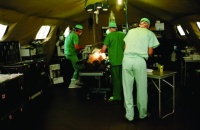
Saeed Zahedi, technical director of prosthetic and orthotics supplier Chas A Blatchford and Sons, said many soldiers that have suffered blast injuries must undergo above-the-knee amputations of both legs.
Decades ago these soldiers would likely have been wheelchair bound, he said, because prosthesis fittings in these cases were rarely successful.
Now a host of technologies are being developed to give these soldiers the kind of mobility they had prior to being wounded.
Zahedi said Blatchford’s latest focus is on the socket, which most affects an amputee’s comfort because it is the interface between the end of the remaining limb and prosthesis.
Blatchford is working with Bournemouth University on an intelligent socket that uses sensors to monitor pressures at the limb and prosthesis interface. This information, which indicates the level of a patient’s comfort, will then be fed into a computer where an algorithm will model the interface pressure.
By knowing the location of the source of discomfort, a caster can better modify the socket. Zahedi said that engineers at Blatchford discovered comfort can be empirically measured by looking at the way loads are distributed over an amputee’s body. For instance, he said, amputees with a single lower limb missing will put much more pressure on their good leg, compared to their prosthetic leg, when standing on a slope.
Zahedi said Blatchford has developed advanced prosthetic ankles designed to even out pressure distributions, but the technology is still challenged by patients with multiple amputations. Blatchford is working on micro-processor-controlled ankles and knees to incorporate
into prosthetics for patients missing both of their lower limbs.
’We are trying to get the ankles and knees to “talk” to each other because bilateral amputees don’t have a sound leg to act as an engine for driving them,’ he said.
Zahedi said another challenge with bilateral amputees is that they must work harder to move, which means they sweat. ’The small stumps at the end of the remaining limbs are worked very hard and get hot and sweat,’ he said. ’When you have sweat, the sweat will create a film and make the socket slip.’
Blatchford has received funding from the Ministry of Defence (MoD) to develop a fluid-management system to work out sweat and keep the interface dry and adhesive.
MoD figures show that, between April 2006 and December 2009, 168 soldiers suffered amputations from Afghanistan, while 20 required amputations as a result of fighting in Iraq. Zahedi said amputee soldiers present a challenge because they are often young and may require care for the next 20 to 40 years.
Therefore, he said, there is a benefit to developing technology that requires less patient monitoring. Looking into the future, Zahedi said it could be possible to make an intelligent socket that not only monitors pressure, but also adjusts itself to meet a patient’s comfort needs.
Siamak Noroozi, chair of Advanced Technology at Bournemouth University, said sockets that adjust themselves could make patients feel like heir prosthesis is more a part of their body, rather than an attached mechanical instrument.
Noroozi added that it could also eliminate the time-consuming trips to prosthesis clinics for readjustments. ’If we can remove all of those issues that affect a patient’s quality of life we can make some positive contributions,’ he said.
Siobhan Wagner
Frazer-Nash is developing an instrumented wheelchair wheel that will support the rehabilitation of injured service personnel at the Headley Court Defence Medical Rehabilitation Centre. The centre supports war casualties, with many undergoing intensive amputee and prosthetic therapy. The wheel will be designed to measure the loads that the patient is putting into the operation of the wheelchair and monitor the progress that is made over the rehabilitation period.
The wheelchair works by measuring data using a load-sensing element, which is transmitted wirelessly to a computer. The data is interpreted, displayed and stored on the computer, enabling information to be analysed during the effort and post-event. The users will gain immediate feedback on the effort they are putting in, while physiotherapists and clinicians will be able to use more detailed information to help to inform on ’best practice’ for the user’s training regimes.




April 1886: the Brunkebergs tunnel
First ever example of a ground source heat pump?